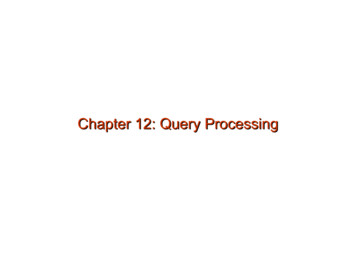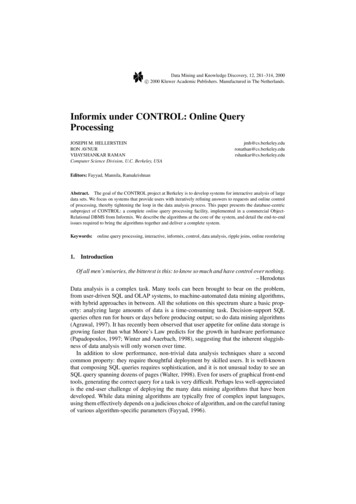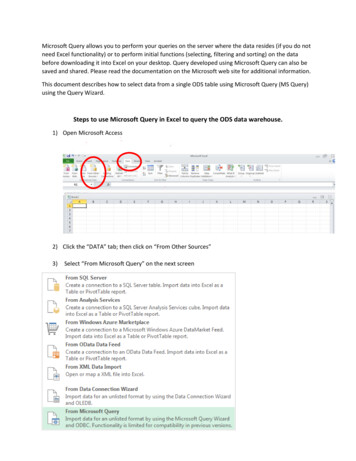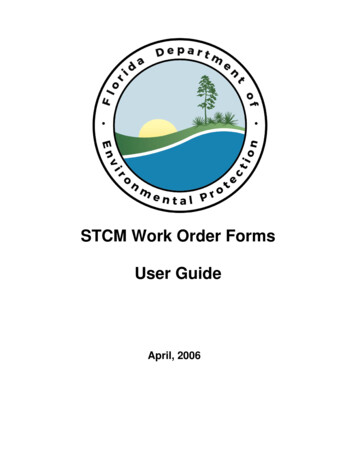
Transcription
Chapter 12: Query Processing
Basic Steps in Query Processing1. Parsing and translation2. Optimization3. Evaluation
Basic Steps in Query Processing (Cont.) Parsing and translation– translate the query into its internal form. This is then translated intorelational algebra.– Parser checks syntax, verifies relations Evaluation– The query-execution engine takes a query-evaluation plan, executes thatplan, and returns the answers to the query. Optimizer– there are many ways to execute a query– optimizer picks the one with the lowest cost
SQL execution plan information OracleEXPLAIN PLAN FORSELECT .– Output will be in the PLAN TABLE table– Simple display:SELECT PLAN TABLE OUTPUTFROM TABLE(DBMS XPLAN.DISPLAY());– See: http://goo.gl/Ho56k (Oracle Database Performance TuningGuide 10g Release 2 (10.2) section 19: Using Explain Plan) MySQLEXPLAIN SELECT .– Simply returns the results– See: http://goo.gl/Tf5SH (MySQL 5.0 Reference Manual. Section7.2. Obtaining Query Execution Plan Information)
Measures of Query Cost Cost is generally measured as total elapsed time for answering query– Many factors contribute to time cost disk accesses, CPU, or even network communication Typically disk access is the predominant cost, and is also relatively easy toestimate. Measured by taking into account– Number of seeks* average-seek-cost– Number of blocks read * average-block-read-cost– Number of blocks written * average-block-write-cost Cost to write a block is greater than cost to read a block– data is read back after being written to ensure that the write wassuccessful
Measures of Query Cost (Cont.) For simplicity we just use the number of block transfers from disk and thenumber of seeks as the cost measures– tT – time to transfer one block– tS – time for one seek– Cost for b block transfers plus S seeksb * tT S * tS We ignore CPU costs for simplicity– Real systems do take CPU cost into account We do not include cost to writing output to disk in our cost formulae
Selection Operation File scan/Table scan Algorithm A1 (linear search). Scan each file block and test all records tosee whether they satisfy the selection condition.– Cost estimate br block transfers 1 seek br denotes number of blocks containing records from relation r– If selection is on a key attribute, can stop on finding record cost (br /2) block transfers 1 seek– Linear search can be applied regardless of selection condition or ordering of records in the file, or availability of indices Note: binary search generally does not make sense since data is not storedconsecutively– except when there is an index available,– and binary search requires more seeks than index search
Selections Using Indices Index scan – search algorithms that use an index– selection condition must be on search-key of index. A2 (primary index, equality on key). Retrieve a single record that satisfiesthe corresponding equality condition– Cost (hi 1) * (tT tS)– for every key in the index, retrieve one block from disk A3 (primary index, equality on nonkey) Retrieve multiple records.– Records will be on consecutive blocks Let b number of blocks containing matching records– Cost hi * (tT tS) tS tT * b– For every key in index, retrieve as many blocks from disk as necessaryto retrieve all instances of that search key* - hi – height of index
Selections Using Indices A4 (secondary index, equality on nonkey).– Retrieve a single record if the search-key is a candidate key Cost (hi 1) * (tT tS)– Retrieve multiple records if search-key is not a candidate key each of n matching records may be on a different block Cost (hi n) * (tT tS)– Can be very expensive!
Selections Involving Comparisons Can implement selections of the form σA V (r) or σA V(r) by using– a linear file scan,– or by using indices in the following ways: A5 (primary index, comparison). (Relation is sorted on A) For σA V(r) use index to find first tuple v and scan relationsequentially from there For σA V (r) just scan relation sequentially till first tuple v; do not useindex A6 (secondary index, comparison). For σA V(r) use index to find first index entry v and scan indexsequentially from there, to find pointers to records. For σA V (r) just scan leaf pages of index finding pointers to records,till first entry v In either case, retrieve records that are pointed to– requires an I/O for each record– Linear file scan may be cheaper
Implementation of Complex Selections Conjunction:σθ1 θ2 . . . θn(r) A7 (conjunctive selection using one index).– Select a combination of θi and algorithms A1 through A7 that results inthe least cost for σθi (r).– Test other conditions on tuple after fetching it into memory buffer. A8 (conjunctive selection using composite index).– Use appropriate composite (multiple-key) index if available. A9 (conjunctive selection by intersection of identifiers).– Requires indices with record pointers.– Use corresponding index for each condition, and take intersection of allthe obtained sets of record pointers.– Then fetch records from file– If some conditions do not have appropriate indices, apply test inmemory.
Algorithms for Complex Selections Disjunction:σθ1 θ2 . . . θn (r). A10 (disjunctive selection by union of identifiers).– Applicable if all conditions have available indices. Otherwise use linear scan.– Use corresponding index for each condition, and take union of all theobtained sets of record pointers.– Then fetch records from file Negation: σ θ(r)– Use linear scan on file– If very few records satisfy θ, and an index is applicable to θ Find satisfying records using index and fetch from file
Join Operation Several different algorithms to implement joins– Nested-loop join– Block nested-loop join– Indexed nested-loop join– Merge-join– Hash-join Choice based on cost estimate Examples use the following information– Number of records of student: 5,000 takes: 10,000– Number of blocks of student: 100 takes:400
Nested-Loop Join To compute the theta joinrθ sfor each tuple tr in r do beginfor each tuple ts in s do begintest pair (tr,ts) to see if they satisfy the join condition θif they do, add tr ts to the result.endend r is called the outer relation and s the inner relation of the join. Requires no indices and can be used with any kind of join condition. Expensive since it examines every pair of tuples in the two relations.
Nested-Loop Join (Cont.) In the worst case, if there is enough memory only to holdone block of each relation, the estimated cost isnr bs br block transfers, plusn r brseeks If the smaller relation fits entirely in memory, use that as theinner relation.– Reduces cost to br bs block transfers and 2 seeks Assuming worst case memory availability cost estimate is– with student as outer relation: 5000 400 100 2,000,100 block transfers, 5000 100 5100 seeks– with takes as the outer relation 10000 100 400 1,000,400 block transfers and 10,400 seeks If smaller relation (student) fits entirely in memory, the costestimate will be 500 block transfers. Block nested-loops algorithm (next slide) is preferable.
Block Nested-Loop Join Variant of nested-loop join in which every block of inner relation is pairedwith every block of outer relation.for each block Br of r do beginfor each block Bs of s do beginfor each tuple tr in Br do beginfor each tuple ts in Bs do beginCheck if (tr,ts) satisfy the join conditionif they do, add tr ts to the result.endendendend
Block Nested-Loop Join (Cont.) Worst case estimate: br bs br block transfers 2 * br seeks– Each block in the inner relation s is read once for each block in the outerrelation Best case: br bs block transfers 2 seeks. Improvements to nested loop and block nested loop algorithms:– In block nested-loop, use M — 2 disk blocks as blocking unit for outerrelations, where M memory size in blocks; use remaining two blocks tobuffer inner relation and output Cost br / (M-2) bs br block transfers 2 br / (M-2) seeks– If equi-join attribute forms a key or inner relation, stop inner loop on firstmatch– Scan inner loop forward and backward alternately, to make use of theblocks remaining in buffer (with LRU replacement)– Use index on inner relation if available (next slide)
Indexed Nested-Loop Join Index lookups can replace file scans if– join is an equi-join or natural join and– an index is available on the inner relation’s join attribute Can construct an index just to compute a join. For each tuple tr in the outer relation r, use the index to look up tuples in sthat satisfy the join condition with tuple tr. Worst case: buffer has space for only one page of r, and, for each tuple in r,we perform an index lookup on s. Cost of the join: br (tT tS) nr c– Where c is the cost of traversing index and fetching all matching stuples for one tuple or r– c can be estimated as cost of a single selection on s using the joincondition. If indices are available on join attributes of both r and s,use the relation with fewer tuples as the outer relation.
Example of Nested-Loop Join Costs Compute student takes, with student as the outerrelation. Let takes have a primary B -tree index on the attribute ID,which contains 20 entries in each index node. Since takes has 10,000 tuples, the height of the tree is 4,and one more access is needed to find the actual data student has 5000 tuples Cost of block nested loops join– 400*100 100 40,100 block transfers 2 * 100 200 seeks assuming worst case memory may be significantly less with more memory Cost of indexed nested loops join– 100 5000 * 5 25,100 block transfers and seeks.– CPU cost likely to be less than that for block nested loops join
Merge-Join1. Sort both relations on their join attribute (if not already sorted on the joinattributes).2. Merge the sorted relations to join them1.Join step is similar to the merge stage of the sort-merge algorithm.2.Main difference is handling of duplicate values in join attribute — everypair with same value on join attribute must be matched3.Detailed algorithm in book
Merge-Join (Cont.) Can be used only for equi-joins and natural joins Each block needs to be read only once (assuming all tuples for any givenvalue of the join attributes fit in memory Thus the cost of merge join is:br bs block transfers br / bb bs / bb seeks– the cost of sorting if relations are unsorted. hybrid merge-join: If one relation is sorted, and the other has a secondaryB -tree index on the join attribute– Merge the sorted relation with the leaf entries of the B -tree .– Sort the result on the addresses of the unsorted relation’s tuples– Scan the unsorted relation in physical address order and merge withprevious result, to replace addresses by the actual tuples Sequential scan more efficient than random lookup
Hash-Join Applicable for equi-joins and natural joins. A hash function h is used to partition tuples of both relations h maps JoinAttrs values to {0, 1, ., n}, where JoinAttrs denotes thecommon attributes of r and s used in the natural join.– r0, r1, . . ., rn denote partitions of r tuples Each tuple tr r is put in partition ri where i h(tr [JoinAttrs]).– r0,, r1. . ., rn denotes partitions of s tuples Each tuple ts s is put in partition si, where i h(ts [JoinAttrs]). Note: In book, ri is denoted as Hri, si is denoted as Hsi andn is denoted as nh.
Hash-Join (Cont.)
Hash-Join (Cont.) r tuples in ri need only to be compared with s tuples in si Need not becompared with s tuples in any other partition, since:– an r tuple and an s tuple that satisfy the join condition will have the samevalue for the join attributes.– If that value is hashed to some value i, the r tuple has to be in ri and thes tuple in si.
Hash-Join AlgorithmThe hash-join of r and s is computed as follows.1. Partition the relation s using hashing function h. When partitioning a relation,one block of memory is reserved as the output buffer for each partition.2. Partition r similarly.3. For each i:(a) Load si into memory and build an in-memory hash index on it using thejoin attribute. This hash index uses a different hash function than theearlier one h.(b) Read the tuples in ri from the disk one by one. For each tuple tr locateeach matching tuple ts in si using the in-memory hash index. Output theconcatenation of their attributes.Relation s is called the build input and r is called the probe input.
Hash-Join algorithm (Cont.) The value n and the hash function h is chosen such that each si should fit inmemory.– Typically n is chosen as bs/M * f where f is a “fudge factor”, typicallyaround 1.2– The probe relation partitions si need not fit in memory Recursive partitioning required if number of partitions n is greater thannumber of pages M of memory.– instead of partitioning n ways, use M – 1 partitions for s– Further partition the M – 1 partitions using a different hash function– Use same partitioning method on r– Rarely required: e.g., with block size of 4 KB, recursive partitioning notneeded for relations of 1GB with memory size of 2MB, or relations of 36 GB with memory of 12 MB
Handling of Overflows Partitioning is said to be skewed if some partitions havesignificantly more tuples than some others Hash-table overflow occurs in partition si if si does not fit inmemory. Reasons could be– Many tuples in s with same value for join attributes– Bad hash function Overflow resolution can be done in build phase– Partition si is further partitioned using different hash function.– Partition ri must be similarly partitioned. Overflow avoidance performs partitioning carefully toavoid overflows during build phase– E.g. partition build relation into many partitions, then combine them Both approaches fail with large numbers of duplicates– Fallback option: use block nested loops join on overflowedpartitions
Cost of Hash-Join If recursive partitioning is not required: cost of hash join is3(br bs) 4 nh block transfers 2( br / bb bs / bb ) seeks If recursive partitioning required:– number of passes required for partitioning build relations is logM–1(bs) – 1 – best to choose the smaller relation as the build relation.– Total cost estimate is:2(br bs) logM–1(bs) – 1 br bs block transfers 2( br / bb bs / bb ) logM–1(bs) – 1 seeks If the entire build input can be kept in main memory no partitioning isrequired– Cost estimate goes down to br bs.
Example of Cost of Hash-Joininstructor teaches Assume that memory size is 20 blocks binstructor 100 and bteaches 400. instructor is to be used as build input. Partition it into five partitions, each ofsize 20 blocks. This partitioning can be done in one pass. Similarly, partition teaches into five partitions,each of size 80. This is alsodone in one pass. Therefore total cost, ignoring cost of writing partially filled blocks:– 3(100 400) 1500 block transfers 2( 100/3 400/3 ) 336 seeks
Hybrid Hash–Join Useful when memory sized are relatively large, and the build input is biggerthan memory. Main feature of hybrid hash join:Keep the first partition of the build relation in memory. E.g. With memory size of 25 blocks, instructor can be partitioned into fivepartitions, each of size 20 blocks.– Division of memory: The first partition occupies 20 blocks of memory 1 block is used for input, and 1 block each for buffering the other 4partitions. teaches is similarly partitioned into five partitions each of size 80– the first is used right away for probing, instead of being written out Cost of 3(80 320) 20 80 1300 block transfers forhybrid hash join, instead of 1500 with plain hash-join. Hybrid hash-join most useful if M bs
Complex Joins Join with a conjunctive condition:r θ1 θ 2 . θ n s– Either use nested loops/block nested loops, or– Compute the result of one of the simpler joins rθis final result comprises those tuples in the intermediate resultthat satisfy the remaining conditionsθ1 . . . θi –1 θi 1 . . . θn Join with a disjunctive conditionrθ1 θ2 . θn s– Either use nested loops/block nested loops, or– Compute as the union of the records in individual joins r(rθ1 s) (rθ2s) . . . (rθns)θ i s:
Other Operations Duplicate elimination can be implemented via hashing or sorting.– On sorting duplicates will come adjacent to each other, and all but oneset of duplicates can be deleted.– Optimization: duplicates can be deleted during run generation as well asat intermediate merge steps in external sort-merge.– Hashing is similar – duplicates will come into the same bucket. Projection:– perform projection on each tuple– followed by duplicate elimination.
Other Operations : Aggregation Aggregation can be implemented in a manner similar to duplicateelimination.– Sorting or hashing can be used to bring tuples in the same grouptogether, and then the aggregate functions can be applied on eachgroup.– Optimization: combine tuples in the same group during run generationand intermediate merges, by computing partial aggregate values For count, min, max, sum: keep aggregate values on tuples found sofar in the group.– When combining partial aggregate for count, add up theaggregates For avg, keep sum and count, and divide sum by count at the end
Other Operations : Set Operations Set operations ( , and ): can either use variant of merge-join aftersorting, or variant of hash-join. E.g., Set operations using hashing:1.Partition both relations using the same hash function2.Process each partition i as follows.1.Using a different hashing function, build an in-memory hash index onr i.2.Process si as follows r s:1. Add tuples in si to the hash index if they are not already in it.2.At end of si add the tuples in the hash index to the result.
Other Operations : Set Operations E.g., Set operations using hashing:1. as before partition r and s,2. as before, process each partition i as follows1.build a hash index on ri2.Process si as follows r s:1. output tuples in si to the result if they are already there in thehash index r – s:1. for each tuple in si, if it is there in the hash index, delete it fromthe index.2. At end of si add remaining tuples in the hash index to theresult.
Other Operations : Outer Join Outer join can be computed either as– A join followed by addition of null-padded non-participating tuples.– by modifying the join algorithms. Modifying merge join to compute rss, non participating tuples are those in r – ΠR(r s)– In r– Modify merge-join to compute rs: During merging, for every tuple tr from r that do not match any tuplein s, output tr padded with nulls.– Right outer-join and full outer-join can be computed similarly.
Other Operations : Outer Join Modifying hash join to compute rs– If r is probe relation, output non-matching r tuples padded with nulls– If r is build relation, when probing keep track of whichr tuples matched s tuples. At end of si outputnon-matched r tuples padded with nulls
Sorting We may build an index on the relation, and then use the index to read therelation in sorted order. May lead to one disk block access for each tuple. For relations that fit in memory, techniques like quicksort can be used. Forrelations that don’t fit in memory, externalsort-merge is a good choice.
External Sort-MergeLet M denote memory size (in pages).1. Create sorted runs. Let i be 0 initially.Repeatedly do the following till the end of the relation:(a) Read M blocks of relation into memory(b) Sort the in-memory blocks(c) Write sorted data to run Ri; increment i.Let the final value of i be N2. Merge the runs (next slide) .
External Sort-Merge (Cont.)2. Merge the runs (N-way merge). We assume (for now) that N M.1.2.3.Use N blocks of memory to buffer input runs, and 1 block to bufferoutput. Read the first block of each run into its buffer pagerepeat1. Select the first record (in sort order) among all buffer pages2. Write the record to the output buffer. If the output buffer is full write itto disk.3. Delete the record from its input buffer page.If the buffer page becomes empty thenread the next block (if any) of the run into the buffer.until all input buffer pages are empty:
External Sort-Merge (Cont.) If N M, several merge passes are required.– In each pass, contiguous groups of M - 1 runs are merged.– A pass reduces the number of runs by a factor of M -1, and creates runslonger by the same factor. E.g. If M 11, and there are 90 runs, one pass reduces the numberof runs to 9, each 10 times the size of the initial runs– Repeated passes are performed till all runs have been merged into one.
Example: External Sorting Using Sort-Merge
External Merge Sort (Cont.) Cost analysis:– Total number of merge passes required: logM–1(br/M) .– Block transfers for initial run creation as well as in each pass is 2br for final pass, we don’t count write cost– we ignore final write cost for all operations since the output of anoperation may be sent to the parent operation without beingwritten to disk Thus total number of block transfers for external sorting:br ( 2 logM–1(br / M) 1)– Seeks: next slide
External Merge Sort (Cont.) Cost of seeks– During run generation: one seek to read each run and one seek to writeeach run 2 br / M – During the merge phase Buffer size: bb (read/write bb blocks at a time) Need 2 br / bb seeks for each merge pass– except the final one which does not require a write Total number of seeks:2 br / M br / bb (2 logM–1(br / M) -1)
Assuming worst case memory availability cost estimate is - with student as outer relation: 5000 100 5100 seeks - with takes as the outer relation If smaller relation (student) fits entirely in memory, the cost estimate will be 500 block transfers. Block nested-loops algorithm (next slide) is preferable.











